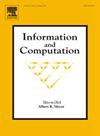可逆电路的渐进优化合成
IF 1
4区 计算机科学
Q3 COMPUTER SCIENCE, THEORY & METHODS
引用次数: 0
摘要
人们对可逆电路进行了广泛而深入的研究,在数字信号处理、密码学,特别是量子计算等各个领域都有大量应用。2003 年,人们证明了 n 线可逆电路合成的下界 Ω(2nn/logn)。这一下界是否有匹配的上界被列为调查报告中未来具有挑战性的开放问题之一(Saeedi 和 Markov (2013) [1])。在本文中,我们提出了一种用不超过 O(2nn/logn) 的基本门实现任意 n 线可逆电路的算法,从而解决了这个开放问题。本文章由计算机程序翻译,如有差异,请以英文原文为准。
Asymptotically optimal synthesis of reversible circuits
Reversible circuits have been studied extensively and intensively, and have plenty of applications in various areas, such as digital signal processing, cryptography, and especially quantum computing. In 2003, the lower bound for the synthesis of n-wire reversible circuits was proved. Whether this lower bound has a matching upper bound was listed as one of the future challenging open problems in the survey (Saeedi and Markov (2013) [1]). In this paper we propose an algorithm to implement an arbitrary n-wire reversible circuit with no more than elementary gates, and thus close the open problem.
求助全文
通过发布文献求助,成功后即可免费获取论文全文。
去求助
来源期刊

Information and Computation
工程技术-计算机:理论方法
CiteScore
2.30
自引率
0.00%
发文量
119
审稿时长
140 days
期刊介绍:
Information and Computation welcomes original papers in all areas of theoretical computer science and computational applications of information theory. Survey articles of exceptional quality will also be considered. Particularly welcome are papers contributing new results in active theoretical areas such as
-Biological computation and computational biology-
Computational complexity-
Computer theorem-proving-
Concurrency and distributed process theory-
Cryptographic theory-
Data base theory-
Decision problems in logic-
Design and analysis of algorithms-
Discrete optimization and mathematical programming-
Inductive inference and learning theory-
Logic & constraint programming-
Program verification & model checking-
Probabilistic & Quantum computation-
Semantics of programming languages-
Symbolic computation, lambda calculus, and rewriting systems-
Types and typechecking
 求助内容:
求助内容: 应助结果提醒方式:
应助结果提醒方式:


